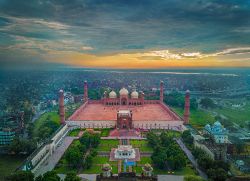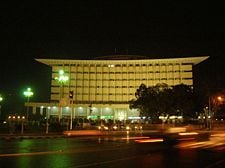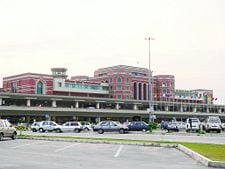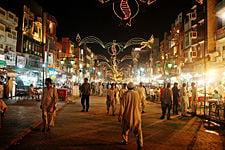Lahore
| Lahore لہور لاہور |
|
| — City District — | |
| Nickname: Paris of the East, The Heart of Pakistan, The Pearl of the Punjab, The Garden of the Mughals, The Cultural Capital of Pakistan, Data Ki Nagri, City of Gardens, City of Festivals | |
| Location in Pakistan | |
| Coordinates: {{#invoke:Coordinates|coord}}{{#coordinates:31|32|59|N|74|20|37|E|type:city | |
|---|---|
| name= }} | |
| Country | |
| City District Government | 11 September 2008 |
| City Council | Lahore |
| Towns | 9 |
| Government | |
| - Type | City District |
| - Divisional Commissioner | Jawad Rafiq (CSP/D.M.G) |
| - City Nazim | |
| - Naib Nazim | |
| - District Coordination Officer | Ahad Khan Cheema (CSP/D.M.G) |
| Area [1] | |
| - Total | 1,772 km² (684 sq mi) |
| Elevation | 217 m (712 ft) |
| Population (2011[2]) | |
| - Total | 11,000,000 |
| Combined population of Lahore City and Lahore Cantonment | |
| Postal code | 54000 |
| Area code(s) | 042[3] |
| Lahore Cantonment is a legally separate military-administered settlement. | |
| Website: lahore.gov.pk | |
Lahore (Punjabi: لہور, Urdu: لاہور pronounced [lahor]) is the second largest city in Pakistan after Karachi, and the capital of Punjab province. It is popularly known as the Heart of Pakistan, due to its historical importance in the creation of Pakistan, and also being a cultural, political and educational center of the country and economic center of the country's biggest province, Punjab. It is also often called the Garden of the Mughals or the City of Gardens because of the heritage of the Mughal Empire. It is located near the Ravi River and Wagah, the only road border crossing between India and Pakistan.
Much of Lahore's architecture from the Mughal and colonial eras has been preserved. Mughal structures such as the Badshahi Mosque, Ali Hujwiri, and the mausoleums of Jehangir, and Nur Jehan are popular tourist spots in the city. Colonial British structures such as the Lahore High Court, General Post Office, and many of the older universities still retain their Mughal-Gothic style. Lahore's Fort and Shalamar Gardens, which were listed as a UNESCO World Heritage Site in 1981, are considered masterpieces of the Mughal era.
Geography
A legend, based on Hindu oral traditions, states that Lahore was named after Lava, son of the Hindu god Rama, who supposedly founded the city. To this day, the Lahore Fort has a vacant temple dedicated to Lava. Lhore is the original name of the city.
Lahore lies 811 miles (1305km) northeast of Karachi in the upper Indus plain on the Ravi River, a tributary of the Indus River, which flows on the northern side of Lahore. The city is bounded on the north and west by the Sheikhupura District, on the east by Wagah, and on the south by Kasur District. Lahore city covers a total land area of 684 square miles (1772 km²).
The weather of Lahore is extreme during the months of May, June, and July, when the average temperature is 87°F (30°C). In August, the monsoon seasons starts, with heavy rainfall throughout the province. December, January, and February are the coldest months, when temperatures drop to 54°F (12°C). The city’s highest maximum temperature was 48.3°C,[4] recorded on June 6, 1921, and again on June 9, 2007.[5] At the time the meteorological office recorded this official temperature in the shade, it reported a heat index in direct sunlight of 131°F (55 °C), lowest temperature recorded is 21°F (-6.0°C).[4] Average annual precipitation is 24.7 inches (628mm).
Population growth and poor water infrastructure have reduced per capita water availability. Solid waste burning, low-quality fuels, and the growing use of fuel-inefficient motor vehicles have contributed to air pollution. The government has addressed environmental concerns with new legislation and institutions such as the Pakistan Environment Protection Council. Yet, foreign lenders provide most environmental protection funds, and only 0.04 percent of the government’s development budget goes to environmental protection.
The old city area of Lahore has newer commercial, industrial, and residential areas ringed by suburbs on the southeast. Parklands have mostly replaced a wall and a moat that once surrounded the old city. Thirteen gates on a circular road provide access to the old city.
History

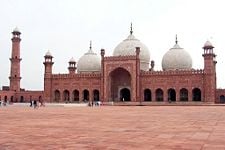
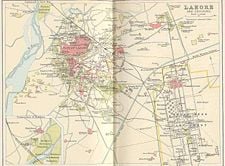
Neolithic populations lived in the region for millennia until settlements along the Indus Valley culminated in the Indus Valley Civilization around 3000 B.C.E. A legend, based on Hindu oral traditions, states that Lava, son of the Hindu god Rama, supposedly founded Lahore.
Ptolemy, the celebrated astronomer and geographer, mentions in his Geographia a city called Labokla[6] situated on the route between the Indus River and Palibothra (Patna), in a tract of country called Kasperia (Kashmir).
The oldest authentic document about Lahore was written anonymously in 982 and is called Hudud-i-Alam.[7] Published in Lahore in 1927, this document describes Lahore as a small shahr (city) with "impressive temples, large markets and huge orchards."[8].
Few references to Lahore exist before its capture by Sultan Mahmud of Ghazni (971-1030) in the eleventh century C.E., after a long siege and battle in which the city was torched and depopulated. In 1021, Mahmud appointed Malik Ayaz to the throne and made Lahore the capital of the Ghaznavid Empire. Ayaz rebuilt and repopulated the city, added city gates, and a fort, built in 1037-1040, on the ruins of the previous one, which had been demolished in the fighting. Under his rule, the city became a cultural and academic center, renowned for poetry. The Khorasanian Sunni Muslim Ghaznavid dynasty existed from 975 to 1187.
After the fall of the Ghaznavid Empire, Lahore was ruled by various Muslim dynasties known as the Delhi Sultanate. When Sultan Qutb-ud-din Aybak was crowned there in 1206, he became the first Muslim sultan of the Indian subcontinent.
A Mongol army sacked Lahore in 1241. In 1398, Lahore fell under the control of the Turkic conqueror Timur (1336–1405).
Guru Nanak (1469–1539), the founder of Sikhism, is said to have received his message near Lahore.
In 1524, Mughal Babur’s troops captured Lahore, making it part of the Mughal Empire, to remain thus until 1752. From 1584 to 1598, during the rules of the emperors Akbar (1542–1605) and Jahangir (1569–1627), the city served as its capital.
Lahore reached a peak of architectural glory during the rule of the Mughals. The massive Lahore Fort was built. A few buildings within the fort were added by Akbar's son, Mughal emperor Jahangir, who is buried in the city. Jahangir's son, Shah Jahan, was born in Lahore. He, like his father, extended the Lahore Fort and built many other structures in the city, including the Shalimar Gardens. The last of the great Mughals, Aurangzeb, who ruled from 1658 to 1707, built the city's most famous monuments, the Badshahi Masjid and the Alamgiri Gate next to the Lahore Fort.
After the death of Aurangzeb in 1707, Lahore was the location of a power struggle between Mughal rulers and Sikh insurrectionists. Persian military leader Nadir Shah (1698–1747) invaded India in 1738, making Lahore an outpost of the Iranian empire. The city had nine different governors between 1745 and 1756. Bands of warring Sikhs gained control in some areas.
In 1799, all Sikh Misls joined into one to form a sovereign Sikh state, becoming the seat of a government during the rule of Maharaja Ranjit Singh(1799-1839). Singh resisted British incursions for more than 40 years.
After Singh’s death, the city declined, and passed under British rule in 1849, which lasted to 1947. During that time, British construction in Lahore combined Mughal, Gothic and Victorian styles.
The 1929 Congress session was held at Lahore. In this Congress, the Declaration of the Independence of India was moved by Pandit Nehru (1889–1964) and passed unanimously at midnight on December 31, 1929.[9]
Independence fighter Jatin Das (1904–1929) died in Lahore prison after fasting for 63 days in protest of British treatment of political prisoners. Shaheed Sardar Bhagat Singh (1907–1931), was hanged in Lahore Jail.[10]
The most important session of the All India Muslim League, later the Pakistan Muslim League, the premier party fighting for independence, was held in Lahore in 1940.[11] Muslims under the leadership of Quaid-e-Azam demanded a separate homeland for Muslims of India in a document known as the Pakistan Resolution or the Lahore Resolution.
At independence in 1947, Lahore was made capital of Punjab province in the new state of Pakistan. The British divided India into three parts: The central part, with a Hindu majority, became modern-day India; the western part along with parts of Punjab became West Pakistan, while East Bengal (the Muslim majority part of Bengal) became East Pakistan.
The Partition of India resulted in rioting in which one to five million Muslims, Sikhs, Hindus, and others lost their lives, and millions more became refugee migrants to the newly formed Islamic Republic of Pakistan. These riots damaged historic monuments such as the Lahore Fort, Badshahi mosque, as well as colonial buildings.[12]
In 1971, economic and political discontent in East Pakistan—geographically separated from West Pakistan—and violent political repression escalated into a civil war in East Pakistan and the Indo-Pakistani War of 1971. The latter resulted in the secession of East Pakistan, which formed the independent state of Bangladesh.
Government
The Islamic Republic of Pakistan is a federal republic in which the president, who is elected by secret ballot through an electoral college comprising the members of the Senate, National Assembly, and the provincial assemblies for a five-year term, is the chief of state (and the prime minister)—who is selected by the National Assembly, is head of government.
The bicameral parliament, or Majlis-e-Shoora, consists of the Senate, of 100 members indirectly elected by provincial assemblies and the territories' representatives in the National Assembly, to serve six-year terms, and the National Assembly, of 342 members, 272 of whom are elected by popular vote, 60 seats are reserved for women, and 10 seats reserved for non-Muslims, all to serve five-year terms.
Pakistan is a federation of four provinces, a capital territory, and federally administered tribal areas. Lahore is the capital of Punjab province, which has 35 districts.
Lahore consisted of six towns until a revamp in 2001, when it was tagged as a city district, and three new towns were added. Under each town there are union councils, each of which consists of numerous areas.
Economy
Pakistan, an impoverished and underdeveloped country, has suffered from decades of internal political disputes, low levels of foreign investment, and a costly, ongoing confrontation with neighboring India. Per capita gross domestic product was estimated at $2,600 in 2008. [13]
As of 2005, the Lahore's GDP by purchasing power parity (PPP) was estimated at $28-billion with an average growth rate of 5.9 percent, ranked 122nd in the world.
Central to Lahore's economy is the Lahore Stock Exchange (LSE), Pakistan's second largest stock exchange. The city has numerous government institutes and international companies headquartered in the city, including WorldCALL Telecom Group, Pakistan Railways, Pakistan Cricket Board, Punjab University, NCA, Bata shoes, Haier, Wateen Telecom, Warid Telecom, Honda, Reebok, Daewoo, Nestle, Audi, Coca Cola, Tetra Pak, Monsanto, Delaval, Metro Cash & Carry, Mr Cod, Porsche and Rolls Royce.
Lahore is the largest city of the most populous province of Pakistan, and has the most developed communications infrastructure in the province, which includes a wide network of fiber optic telephone and cable lines, GSM mobile network, IPP and WiMax. It also has the most developed education and health sectors.
Lahore is famous for hand-made carpet manufacturing in Pakistan. Craftsmen in Lahore produce almost every type of hand-made carpet using popular motifs such as medallions, paisleys, traceries, and geometric designs. Lahore is famous for single-wefted designs in Turkoman and Caucasian style and double-wefted Mughal types.
Lahore has extensive road links to all major cities in Punjab. The Grand Trunk Road, completed in 1997, links Lahore with Islamabad. The Pakistan Railways headquarters is located in Lahore, and the Lahore Central Railway Station, built during the British colonial era, is located in the heart of the city.
Lahore struggles for safety on its roads. Massive congestion occurs every day as millions of Lahoris travel through disorganized, fast-moving traffic, and accidents are rife. The government is trying to improve traffic conditions by constructing overhead bridges, underpasses, and conducting public safety campaigns. Plans exist for a high-speed railway between Lahore and Rawalpindi.
The Lahore Rapid Mass Transit System was expected to be completed in 2020.
A new city airport, named Allama Iqbal International Airport, was opened in in 2003. The previous airport now operates as the Hajj Terminal to facilitate the great influx of pilgrims traveling to Saudi Arabia to perform the hajj every year. Lahore also has a general aviation airport known as Walton Airport.
Demographics
Lahore's population was 6,319,000 in 2007, making it the second largest city in Pakistan, the fifth largest city in South Asia and the 23rd largest city in the world.
According to the 1998 census, 86.2 percent of the population were Punjabis and 10.2 percent were Urdu speakers. Finally, three percent Pashto and the Seraikis at 0.4 percent.[14] Figures were unavailable for the many Afghan refugees and migrants from Iran who have permanently settled in Lahore but were not included in the census.
Punjabi and Urdu are the most widely-spoken languages in Lahore and rural areas. Urdu and English, however, are becoming more popular with younger generations since they are officially supported, whereas Punjabi has no official patronage. Many people mix Punjabi with colloquial Urdu.
According to the 1998 census, 93.9 percent of Lahore's population is Muslim, up from 50.1 percent in 1941. Other religions include Christians 5.80 percent (higher in rural areas where they form around 9.0 percent of the rural population) as well as Ahmadis at 0.20 percent and a small number of Bahá'ís, Hindus, Parsis, and Sikhs. In 1941, Lahore had 36.3 percent Hindus and 18.4 percent Sikhs.
There are numerous mosques, shrines, Hindu and Jain temples, gurdwaras, and churches across the city. These include, Badshahi Masjid, Dai Anga Mosque, Data Durbar Complex, Shia Masjid, Suneri Mosque, Wazir Khan Mosque, Moti Masjid, Masjid-e-Shuhda (Martyr's Mosque) and Mosque of Mariyam Zamani Begum. Some of the famous shrines include, Tomb of Muhammad Iqbal, Bibi Pak Daman, Samadhi of Ranjit Singh, Tomb of Shah Jamal, Tomb of Lal Hussain, Tomb of Anārkalī, Tomb of Jahangir, Tomb of Empress Nur Jehan and Tomb of Abdul Hasan Asaf Khan. Some of the well-known churches include, Regal Church, Hall Road Church, Convent of Jesus & Mary, and Saint Anthony's Church.
Lahore is the education capital of Pakistan, and is the country's science and technology hub. Universities include the Lahore University of Management Sciences, the National University Of Computer and Emerging Sciences, the Lahore School of Economics, the University of Management and Technology (Pakistan), and the University of the Punjab, which is the oldest institute of higher learning in the country. There is also the National College of Arts, the Government College Lahore, Forman Christian college, and the University of Central Punjab, the University of Engineering and Technology, COMSATS, and Lahore Chitrkar, which is the only private institute which offers classes in painting, various music instruments and Kathak dance.
Culture
The Lahore Fort, located in the northwestern corner of the Walled City of Lahore, is a World Heritage Site. Other Mughal structures, such as the Badshahi Mosque, Ali Hujwiri, and the mausoleums of Jehangir, and Nur Jehan are popular tourist spots.
The Shalimar Gardens were laid out during the reign of Shah Jahan and were designed to mimic the Islamic paradise of the afterlife described in the Quran.
Lahore is a festive city. Eid ul-Fitr, a Muslim holiday that marks the end of Ramadan, the Islamic holy month of fasting, and Eid ul-Adha, another Muslim festival to commemorate the willingness of Ibrahim to sacrifice his son Ishmael, are celebrated.
Basant is a Hindu festival marking the coming of spring, and is when kite-flying competitions took place on city rooftops until they were banned. The Festival of Lamps, or Mela Chiraghan, is celebrated at the same time as Basant, outside the Shalimar Gardens.
The National Horse and Cattle Show, held in spring in the Fortress Stadium, includes a livestock display, horse and camel dances, tent pegging, colorful folk dances, and mass-band displays.
Independence Day is celebrated on August 14. Parades of the Pakistan Army and Pakistan Air Force are held early in the morning. Concerts are held with many pop and classical singers.
The World Performing Arts Festival, held each November at the Alhambra cultural complex, is a 10-day festival consisting of musicals, theater, concerts, dance, solo, mime, and puppetry shows.
Food streets are cordoned off in the evenings for pedestrian traffic only, and numerous cafés serve local delicacies. There are shisha bars, which offer flavored tobacco pipes commonly found in Middle Eastern nations, attractive food outlets and musical concerts and shows. Alcohol is available to foreigners who request it at certain hotels, but generally not sold in public.
For traditional shopping, the alleys and lanes of the Anarkali and Ichhra bazaars are full of traditional wares like leather articles, embroidered garments, glass bangles, beaten gold and silver jewelry, and creations in silk.
Lahore has also been home to Pakistan's classical music, ghazals and Qawalis. The city is the birthplace of rock bands such as Jal, Call the band, Roxen, Noori and Entityparadigm, which were hugely popular.
Pakistan's film industry is based in the city and is called Lollywood.
Gaddafi Stadium is one of the biggest cricket stadiums in Asia. Nearby is an athletics stadium, a basketball pitch, the Al Hamra, open-air hall similar in design to the coliseum, and the world's largest field hockey stadium, another Cricket Ground, the headquarters of Pakistan Cricket Board, and the Pakistan Football Federation, as well as the multi-sport Punjab Stadium.
Looking ahead
The Pakistani government, in 2009, was struggling to control Islamist militants, and faced a deteriorating economy as foreign exchange reserves declined, the currency depreciated, and the current account deficit widened.[13] Lahore faced challenges posed by rapid population growth and poor water infrastructure. Solid waste burning, low-quality fuels, and the growing use of fuel-inefficient motor vehicles have contributed to air pollution.
With the Lahore Fort and Shalamar Gardens as a World Heritage Site, with a large collection of Mughal and colonial buildings, with festivals, and distinctive cuisine, the city will continue as a tourist drawcard. Lahore does have economic advantages over other cities in Pakistan. It remains the biggest city of the most populous province, Punjab, and has the most developed communications infrastructure in that province.
Notes
- ↑ Punjab Portal. Government of Punjab. Retrieved May 14, 2012.
- ↑ "Laid-back Lahore faces a frightening future", guardian.co.uk, The Observer, UK, March 8, 2009. Retrieved November 20, 2010.
- ↑ National Dialing Codes. Pakistan Telecommunication Company Limited. Retrieved May 14, 2012.
- ↑ 4.0 4.1 Pakistan Meteorological Department. Lahore during 1931-2006 Retrieved February 7, 2009.
- ↑ The Dawn Newspapers. June 10, 2007. Heatwave to persist for 4-5 days Retrieved February 7, 2009.
- ↑ Digital South Asia Library. Imperial Gazetteer of India, v. 16, p. 106 Retrieved February 7, 2009.
- ↑ V.V. Barthold, 982 C.E., HUDUD AL-'ALAM 'The Regions of the World' A Persian Geography Aris & Phillips. Retrieved February 7, 2009.
- ↑ Majid Sheikh, Dawn Pakistan - The 'shroud' over Lahore's antiquity The Dawn Newspapers. Retrieved February 7, 2009.
- ↑ The Tribune. January 27, 1999. Republic Day Retrieved February 7, 2009.
- ↑ Daily Times. September 2, 2007. Memorial will be built to Bhagat Singh, says governor Retrieved February 7, 2009.
- ↑ Story of Pakistan. June 1, 2003. - Lahore Resolution 1940 Retrieved February 7, 2009.
- ↑ William Dalrymple, Lahore: Blood on the Tracks Travel Intelligence.
- ↑ 13.0 13.1 CIA World Factbook. 2009. Pakistan.
- ↑ Find Pakistan. Lahore Retrieved February 7, 2009.
ReferencesISBN links support NWE through referral fees
- Brown, T. Louise. 2005. The dancing girls of Lahore: selling love and hoarding dreams in Pakistan's ancient pleasure district. New York: Fourth Estate. ISBN 9780060740429
- CIA World Factbook. 2009. Pakistan Retrieved January 31, 2009.
- Halliday, Tony, Omar Noman, and Tahir Ikram. 1998. Pakistan. Insight Guides. Singapore: APA. ISBN 0887297366.
- Hamid, Abdul. 2008. Lahore Lahore aye. Lahore: Vanguard Books. ISBN 9789694025117
- Jenkins, Simon. January 11, 2008. Here in the city of Kim, Pakistan's magnificent history is being left to rot The Guardian. Retrieved February 7, 2009.
- Lahore Museum (Pakistan). 2006. Masterpieces of Lahore museum. Lahore: Lahore Museum ; in collaboration with Islamabad: United Nations Educational, Scientific and Cultural Organization. OCLC 137232699
- Malik, Hafeez. 2001. Pakistan Founder's Aspirations and Today's Realities. Karachi: Oxford University Press. ISBN 0195793331.
- Raza, M. Hanif. 1994. Portrait of Pakistan. Lahore: Ferozsons. ISBN 9789690101051
External links
All links retrieved October 21, 2022.
Coordinates:
Credits
New World Encyclopedia writers and editors rewrote and completed the Wikipedia article in accordance with New World Encyclopedia standards. This article abides by terms of the Creative Commons CC-by-sa 3.0 License (CC-by-sa), which may be used and disseminated with proper attribution. Credit is due under the terms of this license that can reference both the New World Encyclopedia contributors and the selfless volunteer contributors of the Wikimedia Foundation. To cite this article click here for a list of acceptable citing formats.The history of earlier contributions by wikipedians is accessible to researchers here:
The history of this article since it was imported to New World Encyclopedia:
Note: Some restrictions may apply to use of individual images which are separately licensed.
